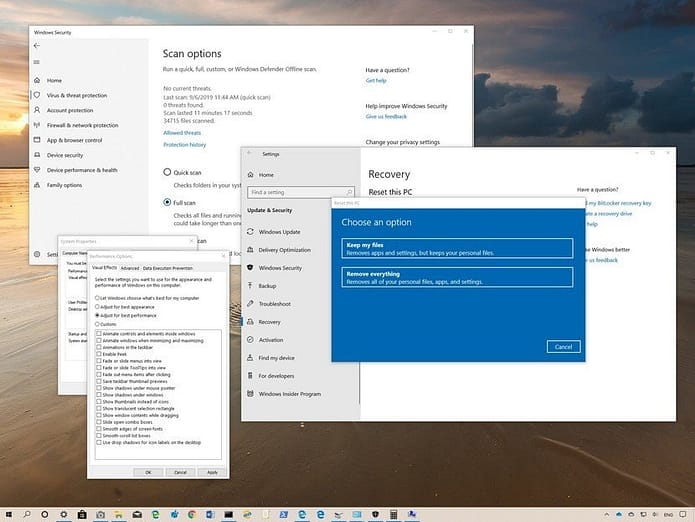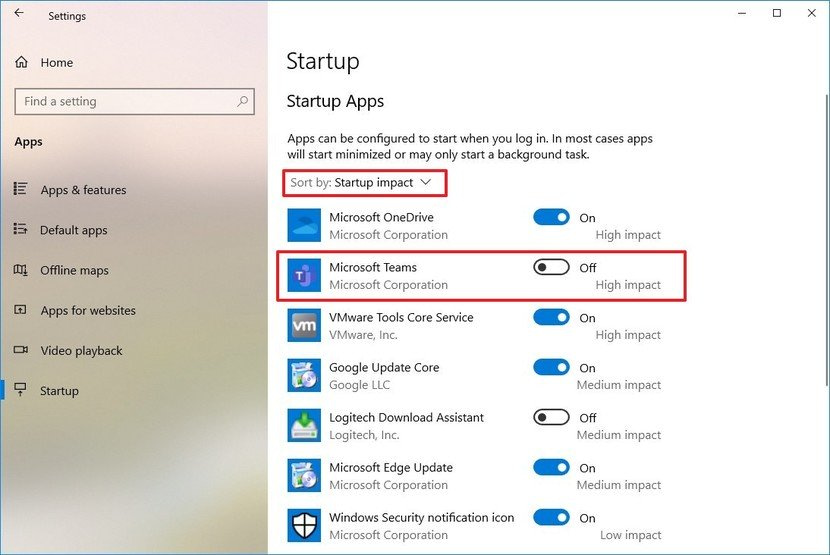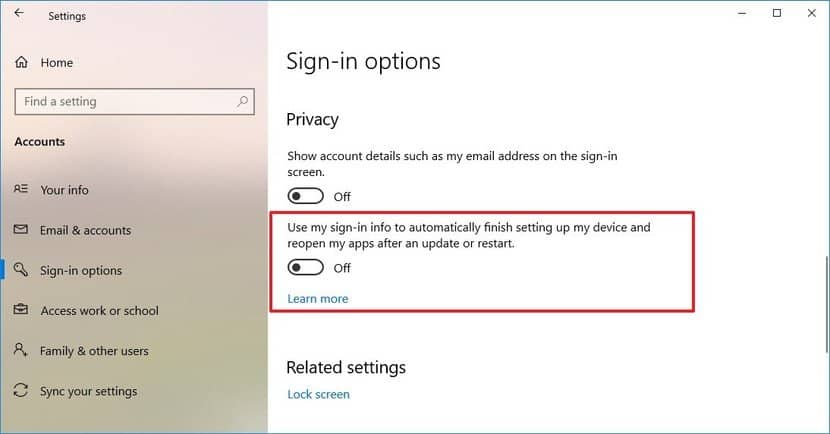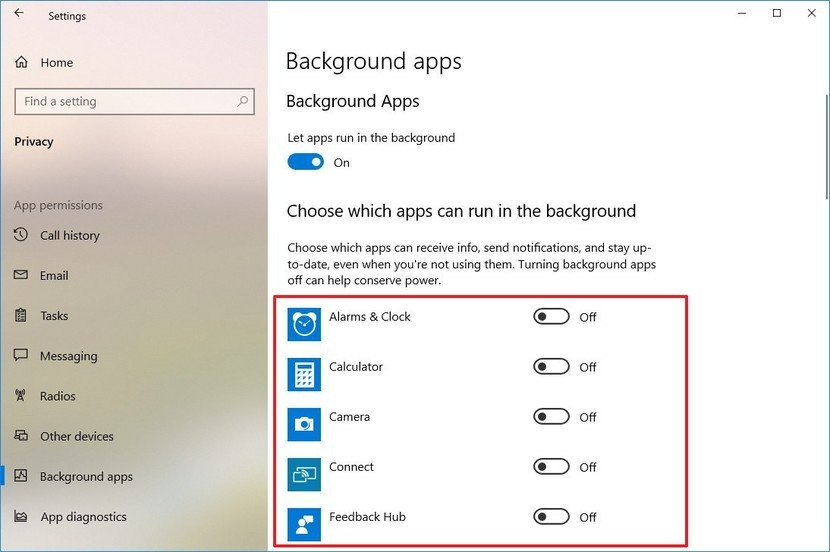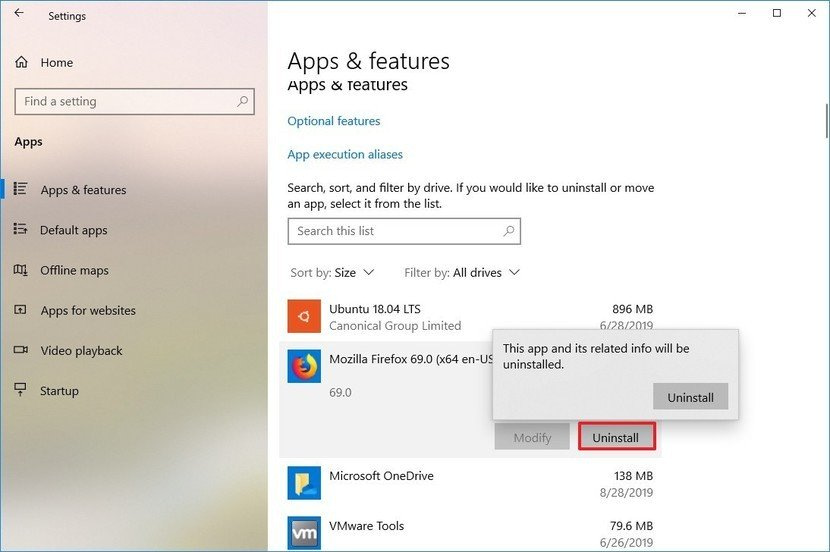If your PC is running slow, use these tips to help speed up and increase the performance of Windows 10.
1. Disable startup apps
Many of the apps installed on your computer can configure themselves to launch automatically during startup and continue to run in the background.
However, if you don’t use those apps on a daily basis, or you don’t have a powerful device, they can waste valuable system resources, which can significantly slow down the experience.
To disable apps at startup on Windows 10, use these steps:
- Open Settings.
- Click on Apps.
- Click on Startup.
- Click the Sort by menu and select the Startup impact option.
Turn off the toggle switch for any application that’s not a priority (especially those marked as „High impact“).
- Restart your computer.
Once you complete the steps, your device should now start faster than before. Of course, levels of improvements will vary depending on the applications you’re disabling and your hardware configuration.
2. Disable relaunch apps on startup
Windows 10 also includes a feature that can restart the apps from your last session after a reboot even before you sign in to your account.
While this feature has been designed to speed up the process to quickly return to your apps, it can also impact the system performance.
If the app re-launch at startup is enabled, you can disable it with these steps:
- Open Settings.
- Click on Sign-in options.
Under the „Privacy“ section, turn off the Use my sign-in info to automatically finish setting up my device and reopen my apps after an upgrade or restart option.
After you complete the steps, apps you’re currently running will no longer reopen during restart speeding up the overall system performance.
3. Disable background apps
Alongside the ability for apps to run at startup, certain apps can continue to perform a number of task in the background even if you’re not using them.
If you want to increase the performance of Windows 10 as much as possible, you can disable the apps that you don’t want to work in the background, or you can disable the feature entirely.
To disable background apps on Windows 10, use these steps:
- Open Settings.
- Click on Privacy.
- Click on Background apps.
Turn off the toggle switch for the apps you want to prevent from running in the background.
- (Optional) Turn off the Let apps run in the background toggle switch to disable the functionality for all Store apps.
Once you complete the steps, apps will not waste system resources when you’re not actively using them to improve performance.
Using the Settings app, you can only manage Microsoft Store apps. If you have traditional desktop apps running in the background, you’ll need to adjust the settings in those programs.
4. Uninstall non-essential apps
Usually, when you purchase a new device, it’ll come with many pre-installed apps that you don’t need, including the usual bloatware and tools that you never use and will only be wasting space and resources on your computer.
You should always consider uninstalling all the apps that you never use to increase system performance:
- Open Settings.
- Click on Apps.
- Click on Apps & features.
- Select the app you want to remove.
Click the Uninstall button.
- If you’re removing a Microsoft Store app, click the Uninstall button again to confirm. If you’re removing a traditional desktop app, you may need to continue with the on-screen directions to finish uninstalling.
After you complete the steps, you may need to repeat the instructions to remove other non-essential apps from your computer.
5. Install only good quality apps
Old, poorly designed, and apps loaded with unnecessary features can negatively affect your device performance. And just because an app comes from a well-known brand doesn’t necessarily mean that it’s a good app.
To keep your computer healthy and snappy, take your time to research, and only install good apps. Whenever possible install apps from the Microsoft Store, which have been checked for performance and security. If you can’t find an app you need in the Store, only then download alternative apps from trusted web sources, and make sure it’s been designed for Windows 10.
6. Reclaim hard drive space
It doesn’t matter whether it’s a Solid-State Drive (SSD) or traditional Disk Hard Drive (HDD), it’s never a good idea to fill up the drive because it’ll affect performance.
If you have a reasonably new computer and begin to notice that apps, file copying, and other tasks take longer than usual, one of the reasons could be that the drive is running low on space. Usually, this becomes noticeable after filling up around 70 percent of the total storage capacity.
One way to keep the storage from affecting performance is to use Storage Sense to delete unnecessary files to reclaim space.
To clean up a drive using Storage Sense, use these steps:
- Open Settings.
- Click on System.
- Click on Storage.
Under the „Local Disk“ section, click the Temporary files item. (If you don’t see the option, click the Show more categories link.)
Check the files that you want to delete.
Quick tip: When selecting the temporary files that you want to delete, consider that selecting the Downloads option will delete everything inside the „Downloads“ folder. If you’re going to keep these files, don’t check this option. Also, if available, you can select to delete the „Previous Windows Installation(s)“ item, but once you delete these files, you won’t be able to roll back to a previous version of the OS.
Click the Remove files button.
Once you complete the steps, if Storage sense was able to free up enough space, you should start to see a boost in performance.
If you use OneDrive, you could also use Files On-demand to free up space, but it’ll require more time to download files, and this guide focuses on performance, as such we’re not listing it as an option. However, if you want to use this feature, you can check our in-depth guide to use OneDrive Files On-demand.
In the case that you’re still running out of space, you can refer to this guide with more tips to optimize the storage space on your computer.
7. Run defragmentation tool
If you’re using an SSD, you won’t see any benefits using the defragmentation tool. However, if your device still using a traditional HDD, using the tool can increase the responsiveness of the system.
To run the defragmentation tool to speed up the system storage, use these steps:
- Open Settings.
- Click on System.
- Click on Storage.
Under the „More storage settings“ section, click the Optimize Drives option.
- Select the drive from the list.
Click the Optimize button.
After you complete the steps, the tool will organize the files to spend less time seeking for them the next time they’re needed, which will result in a noticeable improvement in performance. The time to complete the process will depend on the drive size, data on the drive, and system configuration.
8. Enable ReadyBoost
If you have an older device still using a traditional rotating platter hard drive, you can enable ReadyBoost to increase the performance of your computer.
ReadyBoost is a feature that has been around for a long time, and it uses a removable drive, such as a flash drive or SD card, to cache files and boosts the overall performance without the need of adding more memory.
Important: If you’re using an SSD, you don’t need to enable ReadyBoost as you won’t see any benefit.
To enable ReadyBoost on Windows 10, connect a USB flash drive, and use these steps:
- Open File Explorer.
- Click on „This PC“ from the left pane.
Under the „Devices and drives“ section, right-click the USB flash drive, and select the Properties options.
Click on the ReadyBoost tab.
Quick tip: You can only use specific devices to enable the feature. If the drive can handle ReadyBoost, Windows 10 will let you know during setup.
Select the Dedicate this device to ReadyBoost option.
- Click the Apply button.
- Click the OK button.
Once you complete the steps, the removable drive should boost the performance of your device.
If you need a USB flash drive that you can use with ReadyBoost, we recommend the SanDisk Extreme Go because of its storage capacity, reliability, and price.
Reliable storage
When you need to use ReadyBoost, the SanDisk Extreme Go (CZ800) is an excellent choice. The USB drive offers up to 128GB of storage with fast transfers speeds up to 200MB/s, it’s backed by the strong brand, and it’s also affordable, at around $21 for 64GB.9. Check computer for malware
Sometimes the reason why your computer is slow is because of malware. Viruses, spyware, adware, and other malicious programs are known to take up a lot of system resources (such as memory, hard drive, and processor) turning a device unusable.
Although every installation of Windows 10 comes with Windows Defender Antivirus, it’s still possible for malware to infect your computer.
If you suspect that your device is infected, you should try running a full virus scan with these steps:
- Open Start.
- Search for Windows Security and click the top result to open the app.
- Click on Virus & threat protection.
Under the „Virus & threat protection updates“ section, click the Check for updates option.
Click the Check for updates button.
- Click on Virus & threat protection from the left pane.
Under the „Current threats“ section, click the Scan options link.
Select the Full scan option.
- Click the Scan now button.
After you complete the steps, Windows Defender Antivirus should be able to detect and delete any malware impacting performance.
Performing a Windows Defender Offline scan
In the case that Windows Defender Antivirus doesn’t start, isn’t able to update its definition, or has problems completing the scan, chances are that your computer is infected with an aggressive malware. In this case, try to use the offline scan feature to remove it:
- Open Start.
- Search for Windows Security and click the top result to open the app.
- Click on Virus & threat protection.
Under the „Current threats“ section, click the Scan options link.
Select the Windows Defender Offline scan option.
- Click the Scan button.
Once you complete the steps, your computer will reboot automatically and perform an offline scan to detect and remove any threats.
If you’re using other antimalware solutions, such as Malwarebytes, Bitdefender, Trend Micro, or Norton, make sure to check their support documentation to remove viruses and other malicious programs.
10. Install latest update
Installing the latest system and driver updates is another great way to increase the performance of Windows 10 — even though, sometimes, they’re the reason why your device is not working correctly.
Installing Windows updates
Updates on Windows 10 happens automatically, but depending on the update, they don’t install as soon as they’re available. If you’re dealing with performance problems, your device may be missing some updates.
To install updates manually on Windows 10, use these steps:
- Open Settings.
- Click on Update & Security.
- Click on Windows Update.
Click the Check for updates button.
- (Optional) Under the „Optional updates available“ section, if there’s a cumulative update available, click the Download and install now option.
- Click the Restart now button.
After you complete the steps, the new update should help to improve system performance.
Upgrading Windows 10 to the latest version
If you’re running an older release, upgrading to the most recent version of Windows 10 can sometimes improve performance. For instance, when Microsoft release version 1903 (May 2019 Update), the feature update included a patch to properly utilize the many cores available on AMD Ryzen processors. After the update, devices using these AMD processors had a jump of up 21 percent on performance for single-threaded tasks.
To upgrade to the latest version of Windows 10, use these steps:
- Open Settings.
- Click on Update & Security.
- Click on Windows Update.
Click the Check for updates button.
- Under the „Feature Update“ section, if there’s a new version available, click the Download and install now option. (If you don’t see the option, it’s likely that your device isn’t yet compatible with the latest version of the OS.)
- Click the Restart now button.
Once you complete the steps, your device will restart automatically to finish applying the new version, which should help to improve system performance.
Updating device drivers
A lot of times, manufacturers will make available stable or pre-release versions of a device driver to improve performance through their support website before it’s published through Windows Update.
If your device is running slow as a result of a compatibility issue or poorly designed driver, you may be able to resolve this problem by updating the device driver manually.
Before proceeding, make sure to download the latest available driver package from your device manufacturer website, uncompress the files using the self-extracting or .zip extension file, and then use these steps:
Important: If available, it’s recommended to use the instructions outlined by your device manufacturer support website.
- Open Start.
- Search for Device Manager and click the top result to open the app.
- Expand the branch for the device you want to update.
Right-click the device, and select the Update Driver option.
Click the Browse my computer for driver software option.
Under the „Search for drivers in this location“ section, click the Browse button to select the folder with the newest device driver.
- Click the Next button.
- Click the Close button.
After you complete the steps, the new version of the driver will install to address compatibility or any other issues impacting system performance.
Updating apps
Outdated apps can also cause your device to run slower, and usually, this is due to bugs or compatibility problems with a new version of Windows 10.
While apps you install from the Microsoft Store will update automatically, many traditional desktop apps need to be updated manually.
If you have an app causing performance problems, it’s a good idea to visit your software support website and follow their instructions to download and install the newest update to improve your system performance.
11. Change power plan
Windows 10 ships with three power plans, including Balanced, Power saver, and High performance to optimize the power usage on your device. If you’re looking to boost performance, you should be using the „High performance“ option, which allows your computer to use more power to run faster.
To choose a different power plan on your computer, use these steps:
- Open Control Panel.
- Click on Hardware and Sound.
Click on Power Options.
Select the High performance power plan.
If the power plan you want to use isn’t available, you can create a custom power plan to improve performance using the „High performance“ settings.
On laptops, you can also change the „Power mode“ to improve performance by tapping or clicking the battery icon in the notification area and setting the slider to the Best performance option.
12. Disable system visual effects
Windows 10 includes many visual effects from animations to shadows to more sophisticated visuals, such as blur and transparency, reveal highlight, and others as part of Fluent Design.
Although these eye-candy effects improve the interaction with the elements on the screen, they also require additional system resources, which on modern hardware isn’t a concern, but they can slow down a machine with older hardware.
If you want to improve the system performance as much as possible, you can disable these effect to save some resources and make Windows 10 seem faster.
Disabling visual effects
To disable animations, shadows, smooth fonts, and other effects, use these steps:
- Open Settings.
- Click on System.
- Click on About.
Under the „Related settings“ section, click the System info option from the right pane.
Click the Advanced system settings link from the left pane.
- Click the Advanced tab.
Under the „Performance“ section, click the Settings button.
- Click the Visual Effects tab.
Select the Adjust for best performance option to disable all the effects and animations.
Quick tip: Using this option will also affect the way fonts are rendered. If you want to keep fonts crisp and more readable, select the Custom option, clear all the settings, but leave the Smooth edges of screen fonts option checked.
- Click the Apply button.
- Click the OK button.
Once you complete the steps, the standard visual effects will disable, and interacting with elements, such as windows and menus, will feel more responsive.
Disabling transparency effects
To disable Fluent Design visual effects on Windows 10, use these steps:
- Open Settings.
- Click on Personalization.
- Click on Colors.
Turn off the Transparency effects toggle switch.
After you complete the steps, Windows 10 will not only feel faster, but your device will free up some system resources for more important tasks.
13. Disable search indexing
While search is an important element of Windows 10, the indexing part can temporarily eat up a lot of system resources, which can impact performance on low-end devices.
If you usually know where your files are located, you can prevent indexing from slowing down your computer with these steps:
- Open Settings.
- Click on Search.
- Click on Search Windows.
Under the „More Search Indexer Settings“ section, click the Advanced Search Indexer Settings option.
Click the Modify button.
Click the Show all locations button.
Clear all the selected locations.
- Click the OK button.
- Click the Close button.
Once you complete the steps, Windows Search will continue to run on your device, but Windows 10 will no longer index the location you specified, which should help to improve the overall performance.
14. Increase page file size
You can also increase the size of the paging file to boost system performance.
The „page file“ is a hidden file on the hard drive that Windows 10 uses as memory, and acts as an overflow of the system memory that holds the data needed for apps currently running on your computer.
To speed up the performance of Windows 10 using page file, use these steps:
- Open Settings.
- Click on System.
- Click on About.
Under the „Related settings“ section, on the right pane, click the System info option.
Click the Advanced system settings link from the left pane.
- Click the Advanced tab.
Under the „Performance“ section, click the Settings button.
- Click the Advanced tab.
Under the „Virtual memory“ section, click the Change button.
- Clear the Automatically manage paging files size for all drives option.
- Select the Custom size option.
Specify the initial and maximum size for the paging file in megabytes.
Quick tip: Usually, it’s recommended to use a number that’s one and a half times the total available memory for the „Initial size“ and three times of available memory for the „Maximum size“ when possible.
- Click the Set button.
- Click the OK button.
- Click the OK button again.
- Restart your computer.
After you complete the steps, the device will restart, and you should then notice a boost in performance when running apps (even more if you’re increasing the paging file size in a Solid-State Drive).
In the event that the new settings are causing issues, you can always revert the changes using the same instructions, but on step No. 10, make sure to select the System managed size option, and check the Automatically manage paging files size for all drives option.
15. Restore previous working state
Sometimes recently installed updates, drivers, or apps may be the reason why your computer is running slow. If this is your case, you can quickly undo changes to improve performance by going back to a previous good working state using a System Restore point.
- Open Start.
- Search for Create a restore point, and click the top result to open the System Properties app.
Click the System Restore button.
- Click the Next button.
- Select the most recent working to restore point that will help you to fix the current problem.
Click the Scan for affected programs button to see the applications that will be removed if they’re installed after the restore point was created.
- Click the Close button.
- Click the Next button.
Click the Finish button.
Once you complete the steps, your computer will go back in time to a previous state where it was running at its optimal performance.
It should be noted that using a restore point won’t delete your files, but it’ll remove system changes, updates, drivers, and applications that were installed after the restore point was created.
System Restore is disabled by default, as such you must set it up before you can revert system changes.
16. Repair installation files
If you’re experiencing performance issues because of corrupted system files, you can use the Deployment Image Service and Management Tool (DISM) and System File Checker (SFC) command-line tools to fix your current installation without the need to reinstall Windows 10.
Fixing installation files with DISM
To use DISM to repair corrupted system files to increase performance and stability, use these steps:
- Open Start.
- Search for Command Prompt, right-click the top result, and click the Run as Administrator option.
Type the following command to repair the installation and press Enter:
DISM /Online /Cleanup-image /Restorehealth
After you complete the steps, if the repair finished successfully, then your device should start operating normally. If the scan had issues, then you should use the SFC command. (You can always learn more about this feature in our DISM walkthrough guide.)
Fixing installation files with SFC
To use SFC to repair corrupted system files on Windows 10, use these steps:
- Open Start.
- Search for Command Prompt, right-click the top result, and click the Run as Administrator option.
Type the following command to repair the installation and press Enter:
sfc /scannow
Once you complete the steps, the SFC tool should be able to fix any problems affecting your system performance.
You can check out this guide that also explains other aspects of the System File Checker tool, including the steps to view scan details, repair individual files, and perform an offline system repair.
17. Reset your device
If nothing seems to increase performance, you can reset your device to start fresh with a clean copy of Windows 10 to improve startup and shutdown, battery life, and overall performance.
Warning: If you’re choosing not to keep your files, it’s recommended to create a full backup of your PC or at least make a copy of your files to an external drive before proceeding.
- Open Settings.
- Click on Update & Security.
- Click on Recovery.
Under the „Reset this PC“ section, click the Get started button.
Click the Keep my files button. (You can also click the Remove everything button to erase everything and install a clean copy of Windows 10.)
Review the apps that will be removed, and click the Reset button.
After you complete the steps, Windows 10 will be reinstalled removing previous configurations, settings, and apps to help you boost system performance.
In the case you selected the option to remove everything, the last thing left to do after the reset is to restore your files from backup.
If you’re looking to install Windows 10 from scratch, check out our in-depth guide to perform a clean installation.
18. Upgrade to faster drive
If after spending the time tweaking and re-tweaking settings and resetting your device to the factory state, you’re still not seeing any improvements in performance, perhaps it’s time to upgrade that old rotating platters drive to an SSD.
Upgrading to an SSD is one of the best things you can do to increase system performance. In part, it’s because unlike mechanical drives, Solid-State Drives are built without moving parts, which means data can be read and written a lot faster.
On older devices, when replacing the HDD with an SSD, you’ll notice that Windows 10 will start more quickly, demanding apps will show noticeable improvements, and the overall performance will feel faster and snappier.
If you’re looking to make the leap from an HDD to an SSD on your desktop PC, we recommend the Samsung 860 EVO because of its fast performance, reliability, and a five-year warranty. Also, you can check our guide highlighting the best drives the money can buy, and the steps to upgrade the slow drive on your laptop.
Fast drive
The Samsung 860 EVO is one of the most popular Solid-State Drives (SSD) because of reliability and value. Also, because it offers excellent performance (with up to 550MB/s read and 520MB/s write speeds) compared to traditional HDD, and every drive is backed with a five-year warranty.
19. Upgrade system memory
Insufficient system memory or Random Access Memory (RAM) can be one of the main reasons your desktop or laptop is running slow, especially if you work with multiple apps and open numerous tabs in the web browser (Chrome, I’m looking at you).
To make your computer faster, first, you want to know the total amount of memory installed on your device and how much is being used regularly to find out if you need to add more memory.
To view the total and current usage of memory on your device, use these steps:
- Open Start.
- Search for Task Manager, and click the top result to open the app.
- Click the Performance tab.
- Click on Memory from the left pane.
On the right, check the total amount of RAM in the top-right corner, and in the bottom-left corner, under „In use (Compressed),“ you can find the out total amount memory currently in use.
If the total amount of „in use“ memory is constantly high (around 80 percent), you should consider adding more memory sticks.
Although adding more RAM to a computer is relatively a straightforward process, making sure you’re getting the right memory can be tricky. Always remember to use Task Manager to find out the kind of memory you need and if there are any slots available. Also, it’s recommended to check your device manufacturer website to find more specific information about the memory requirements.
BONUS TIP
Windows 10 Ultimate Performance Mode: Trick schaltet Power-Modus frei
Ultimate Performance Mode: So geben Sie Windows die volle Power
Ultimative Leistung mit Vorsicht genießen

